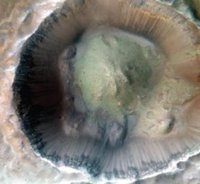
The emerging picture of Mars’ first billion years includes diverse environments involving liquid water and chemical alteration. Clay, carbonate, chloride, and sulfate minerals have all been detected and mapped from orbit in coherent geologic units. When near-infrared spectroscopic detections of minerals from the orbiting CRISM imaging spectrometer are coupled with high-resolution images of morphology provided by orbiting cameras, distinctive aqueous, potentially habitable, environments can be identified, preserved in the geologic record. I will give a global overview of the most recent findings, delve into the details of transitions recorded in a few key stratigraphic sections, and discuss the hypothesis that the most widespread and long-lived aqueous environments on early Mars were in the subsurface.
 Getting Under Europa’s Skin
Getting Under Europa’s Skin Tracing Formation and Evolution of Outer Solar System Bodies Through Stable Isotopes and Noble Gas Abundances
Tracing Formation and Evolution of Outer Solar System Bodies Through Stable Isotopes and Noble Gas Abundances Photosynthesis, a Planetary Revolution
Photosynthesis, a Planetary Revolution Xenon: King of the Gases
Xenon: King of the Gases